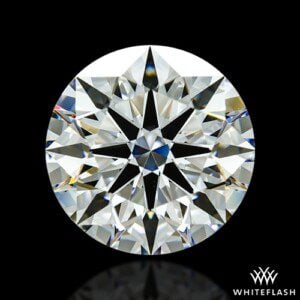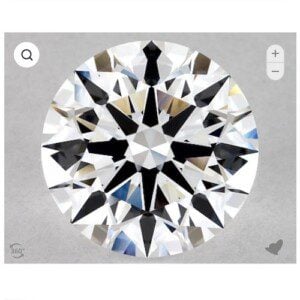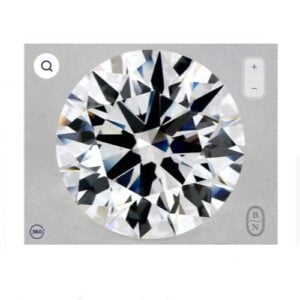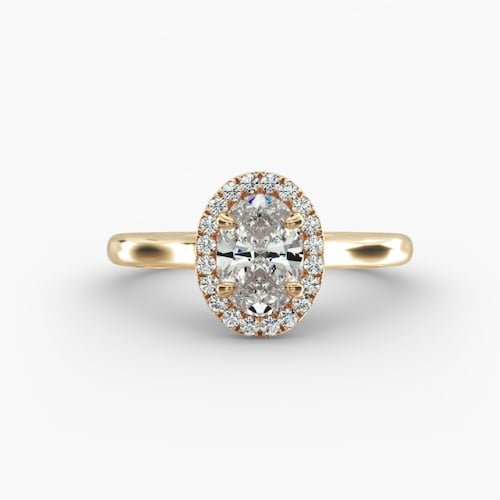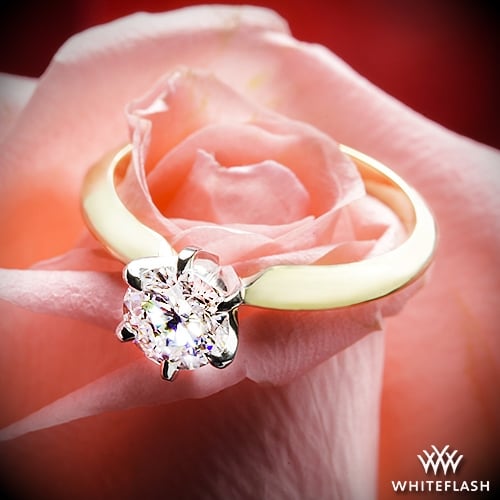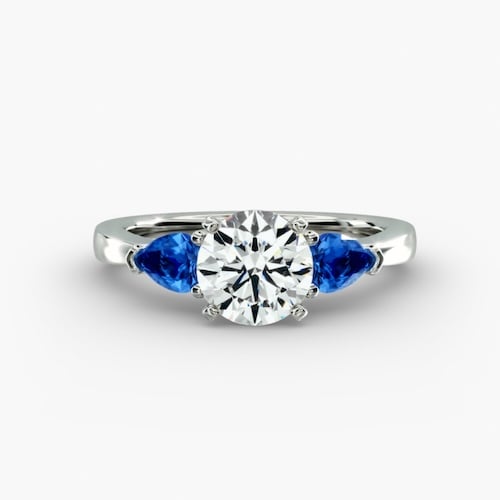A 5-carat diamond ring isn’t simply a purchase or a piece of jewelry; it’s an elegant statement, a timeless investment.
With less than 1% of diamonds reaching the coveted 5-carat category, diamonds with this rating are rare and desirable, and as such, careful consideration is required before making a purchase.
In this PriceScope educational article, we outline the key factors to keep in mind when searching for your perfect 5-carat diamond ring.
Whether you’re investing in a breathtaking engagement ring, an enduring family heirloom, or a beautiful addition to your own jewelry box, we’ll outline everything you need to know about 5-carat diamond rings so you can be assured you’re making the right investment.
What Does a 5-Carat Diamond Ring Cost?
Contrary to popular belief, the cost of a 5-carat diamond ring isn’t solely dictated by its size (although the size of the stone will definitely turn heads). Other key properties such as cut quality, colour, clarity, and shape all significantly impact the price.
Larger diamonds of superior quality are rare and difficult to come by, hence as the carat weight increases, so does the cost per carat. With this in mind, the cost of a high-quality, 5-carat natural diamond can range from $50,000 to more than $200,000.
Staying up-to-date with the current market prices is crucial when searching for your next diamond investment. PriceScope’s latest diamond prices chart provides real-time data on 5-carat diamonds, helping you stay informed, make a wise investment decision, and get the best value for your money.
Lab-Grown 5-Carat Diamonds at PriceScope
The 4Cs in 5-Carat Diamonds
All diamonds are priced and graded according to the 4Cs: cut quality, color, clarity, and carat weight.
Gemological laboratories such as the Gemological Institute of America (GIA) have long set the standard for diamond cut grading. While traditional cut grades range from “Excellent” to “Poor”, the term “Ideal” may be familiar to some having been the highest cut quality rating in the now-retired AGS cut scale.
Today, GIA offers diamonds that not only receive an “Excellent” cut grade, but are also optionally paired with an AGS Ideal light performance report, giving buyers a greater level of assurance.
These dual-certified diamonds – available from trusted vendors like Whiteflash – combine the precision of GIA grading with the performance insights that were once exclusive to AGS.
Why Is Cut Quality for 5-Carat Diamonds So Important?
Given the stone’s size at this carat weight, cut quality is the most important factor when shopping for your 5-carat diamond. The cut quality of a diamond is the key element that determines the diamond’s sparkle and brilliance.
Beyond the basic cut grade, some vendors go a step further by providing in-depth diamond analytics and light performance images, such as ASET, Ideal Scope, and Hearts & Arrows views.
The Gem Certification & Assurance Lab’s 8X® report includes this advanced level of analysis as standard, offering light performance maps and optical symmetry data. For those seeking transparency and assurance in cut quality, diamonds with GCAL 8X® or vendor-supplied imaging – like the Diamond Image Package offered as standard by Whiteflash – are a valuable resource.
Choosing a 5-Carat Diamond That Sparkles
Generally speaking, a higher cut quality, such as an “Excellent” cut diamond, will provide greater sparkle, while a “Poor” cut can make the diamond look dull, regardless of its color and clarity.
Whilst cut quality is the most important factor to consider in a 5-carat diamond, the shape of the stone can likewise affect its visual impact. When shopping for a round 5-carat diamond, we advise looking for an “Excellent” cut to truly draw the eye to the brilliance of your stone, whilst in fancy-shaped diamonds, a cut rated “Very Good” or better will be equally admired.
5-Carat Diamond Color
The color rating of a diamond is given based on the presence of any discernible hue in the stone. The diamond color grades, as outlined by the GIA, range from D (colorless) to Z (light yellow).
According to this scale, diamond color categories are:
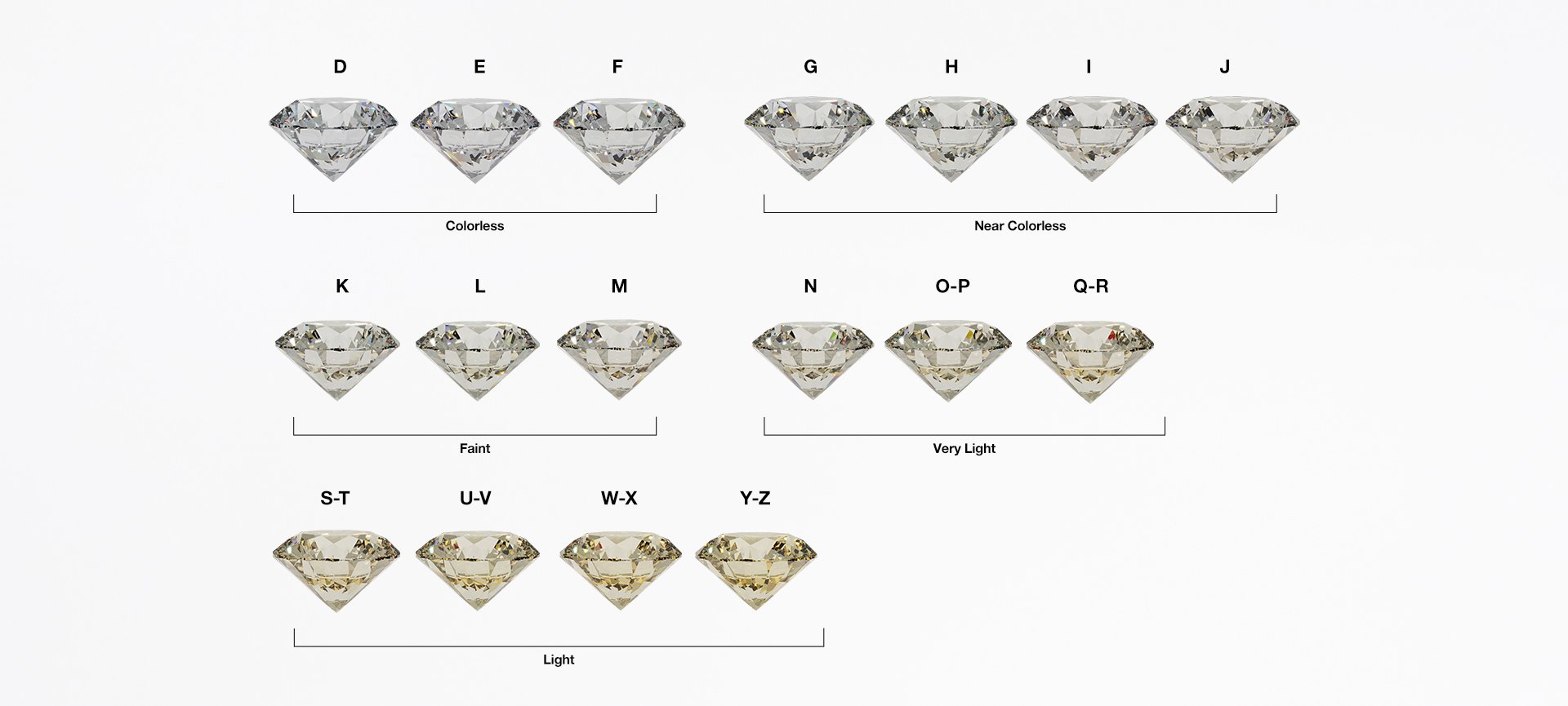
Colorless: D, E, F
Near-Colorless: G, H, I, J
Faint: K, L, M
Very Light: N, O, P, Q, R
Light: S, T, U, V, W, X, Y, Z
Color distinctions between grades can often be very subtle, most often unnoticed by the untrained eye.
For a larger diamond, like a 5-carat, a higher color grade within the colorless range is usually most desirable, as larger stones can often make color tints more visible.
However, the visual appearance of a 5-carat diamond’s color can often be dependent on the diamond’s shape. For example, H and I color-rated diamonds can still appear white/clear in well-cut round diamonds, whilst shapes like cushion or radiant may show more warmth.
5-Carat Diamond Clarity
A diamond’s clarity refers to the number of inclusions and blemishes in the stone. The Gemological Institute of America clarity scale contains 11 grades, established and applied to diamonds when assessed under 10x magnification:
- Flawless (FL)
- Internally Flawless (IF)
- Very, Very Slightly Included (VVS1 and VVS2)
- Very Slightly Included (VS1 and VS2)
- Slightly Included (Sl1 and Sl2)
- Included (I1, I2, and I3)
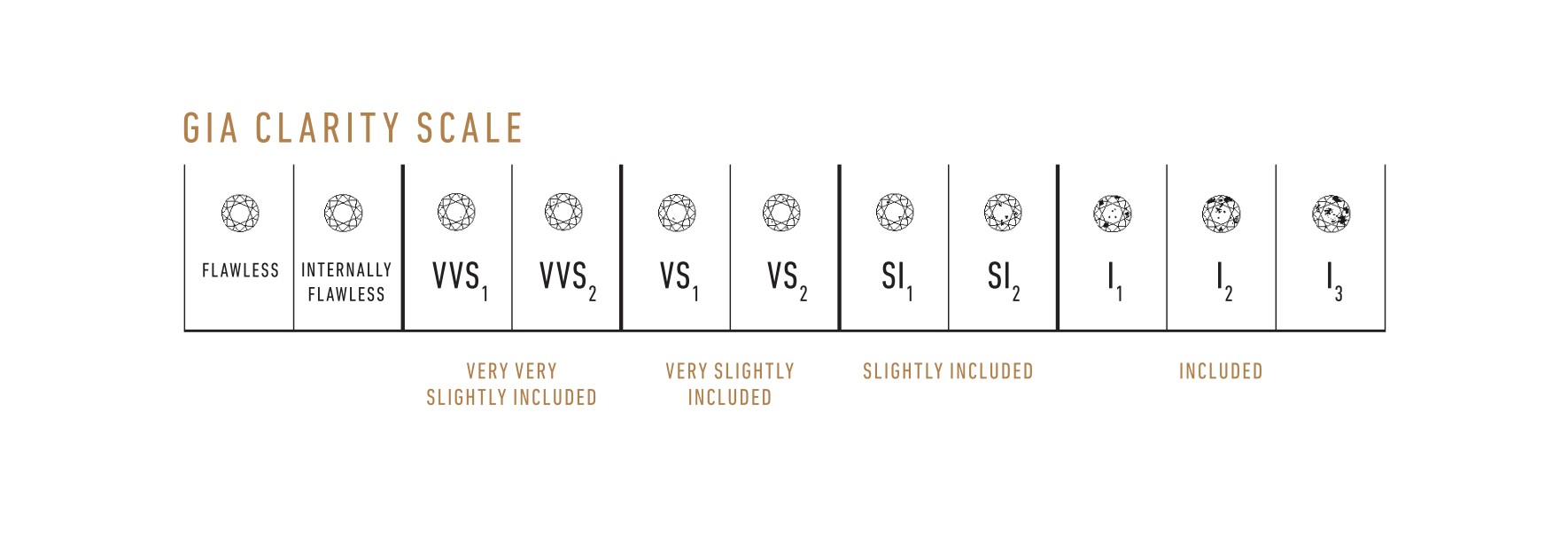
In a 5-carat diamond, it’s advisable to opt for eye-clean clarity (VS2 or better). However, in some shapes, such as emerald or Asscher, a higher clarity grade may be required due to the shape’s open tables.
How Big is a 5-Carat Diamond?
When it comes to shopping for diamonds, it’s important to remember that the carat weight is not equal to a specific size. For example, diamonds with poor proportions (i.e. too deep or too shallow) can look smaller or lack brilliance, despite being in the same carat weight category.
That being said, the carat weight and size of a diamond are often interconnected. A 5-carat diamond typically measures around 11mm in diameter. However, the perceived size can vary depending on its cut.
Shapes like the oval or marquise diamond can appear larger, whilst still weighing 5 carats, due to their elongated structure.
5-Carat Diamond Engagement Ring Inspiration
If your hope is to elicit a gasp from your beloved when you pop the question, a 5-carat diamond ring will definitely help you to achieve just that.
One of the many benefits of investing in a stone of this size is the opportunity it unlocks for customised ring settings. You might choose to enhance the beauty of your diamond by opting for a setting that incorporates complementary side stones (like the basket setting), or surrounds your central stone with smaller diamonds, colored diamonds, or gemstones (like the halo setting).
Most people start by shopping for their perfect 5-carat diamond. Once you’ve settled on your ideal stone, you’ll have a better idea of your remaining budget and the setting options that are open to you.
Find your perfect 5-carat diamond ring setting with the PriceScope Jewelry Search. From classic solitaire to modern halo designs; it’s the perfect place to start planning your engagement ring.
Finding the Perfect 5-Carat Diamond Ring: Choosing the Right Shape
Diamonds are available in a number of different shapes, each of which provides a different look and aesthetic for your ring.

When selecting the shape of your 5-carat diamond, there are a few important considerations to keep in mind. Whilst round cut diamonds, known for their brilliance, are the most popular, other shapes (known as “fancy cuts”) are equally stunning.
It’s important to remember that the ideal diamond shape is usually a matter of personal preference, so when choosing your stone, be sure to think about how it suits your personal style, or the style of the wearer.
The shape of your diamond won’t only impact the final look of your ring, but it can also impact cost, too, which is something to keep in mind if you’re shopping with a budget in place.
Round Cut 5-Carat Diamond Rings
The round cut diamond is the most popular and traditional diamond shape, accounting for approximately 75% of all diamonds sold. This cut is also, generally, the most expensive given that more waste is created in the cutting process compared with other shapes.
Round cut diamonds provide a classic and timeless aesthetic, with the shape emphasizing the stone’s brilliance and sparkle.
Shop Round Cut Natural Diamonds & Lab-Grown Diamonds at Whiteflash.
Princess Cut 5-Carat Diamond Rings
The princess cut diamond became popular in the early 2000s and has long been the second-most-popular diamond cut — until it was recently overtaken by the cushion cut.
The princess cut’s distinctive square shape with pointed corners provides a classic yet contemporary feel, best emphasized when set with box claws to show off the diamond’s shape and sparkle.
Shop Princess Cut Diamonds at PriceScope
Oval Cut 5-Carat Diamond Rings
The elongated shape of the oval cut diamond makes it a popular choice with buyers, as the stone often appears larger than its carat weight suggests. It’s a soft shape that offers lots of sparkle and complements the style of anyone who wears it.
Shop Oval Cut Diamonds at Blue Nile
Pear Cut 5-Carat Diamond Rings
Also known as the teardrop shape, the pear cut diamond has been gaining in popularity since the mid 2010s. Paired beautifully with a solitaire setting or pavé shoulders, the pear cut exudes both brilliance and elegance, providing a flattering look that elongates the finger.
Shop Pear Cut Diamonds at PriceScope
Cushion Cut 5-Carat Diamond Rings
An ever popular choice for engagement rings and investment rings alike is the cushion cut diamond.
Featuring a square shape with rounded corners, the cushion cut brings a touch of vintage charm to your ring, which is highlighted when set in a halo design.
Shop Cushion Cut Diamonds at PriceScope
Emerald Cut 5-Carat Diamond Rings
Elegant and eye-catching, the emerald cut is amongst the most timeless and classic of all the diamond cuts.
The open tables of an emerald cut diamond tend to highlight any inclusions or blemishes, making high diamond clarity an absolute priority when shopping for this shape.
Shop Natural Emerald Cut Diamonds at James Allen
Asscher Cut 5-Carat Diamond Rings
Similar in style to an emerald cut diamond, the asscher cut diamond is a square variation with a smaller table and cropped corners.
Commonly set in a halo design, the asscher cut diamond provides an Art Deco aesthetic. With a deep pavilion and high crown, the diamond’s clarity and brilliance are enhanced, making it an ideal choice for those seeking a timeless design.
Shop Asscher Cut Diamonds at PriceScope
Marquise Cut 5-Carat Diamond Rings
The marquise cut diamond is characterized by its elongated shape with pointed ends. With the largest carat-for-carat surface area of any diamond, the marquise cut will always turn heads.
Shop Marquise Cut Diamonds at PriceScope
Radiant Cut 5-Carat Diamond Rings
Combining the angular shape of the emerald cut with the brilliance and sparkle of the round or cushion cut, the radiant cut diamond is perhaps one of the less popular stone shapes, but is no less beautiful.
Offering clean lines and a unique shape, this style is both glamorous and sophisticated.
Shop Radiant Cut Natural & Lab-Grown Diamonds at Whiteflash
Heart Cut 5-Carat Diamond Rings
A heart cut diamond is a romantic and unique choice for your engagement ring, making the symbol of love the ultimate focal point.
Well-suited to a simple halo setting, the heart shape requires a high degree of skill to ensure the proper symmetry and proportion, so it’s essential to find a reputable jeweler.
Shop Heart Cut Diamonds at James Allen and Blue Nile
The shape of your diamond will significantly influence the overall look and aesthetic of your ring, so it’s important to choose the cut that most appeals to you or your loved one. For information on the most popular diamond shapes this month, see PriceScope’s diamond search data.
Making Sure You Purchase A Certified 5-Carat Diamond
Whatever the motivation for your purchase, a 5-carat diamond is a sizable investment, so it’s important to ensure you choose a reputable seller who can provide complete certifications for your new stone.
This is especially true of lab-grown diamonds — GIA or IGI certification is essential, particularly at this carat weight and price point, to ensure grading accuracy and resale value.
Purchasing from a trusted supplier who can provide genuine certifications for your 5-carat diamond has a number of benefits, including:
1. Authenticity
Diamond certification from a reputable lab, like GIA or IGI, guarantees that the diamond is real and not a synthetic or lookalike stone, such as cubic zirconia or moissanite.
2. Verified Quality
A certified diamond is issued with a report detailing its specification in relation to the 4Cs. This document outlines the diamond’s qualities in terms of carat weight, cut quality, color, and clarity, providing transparency about its characteristics so you have full understanding of your purchase.
3. Value for Money
Diamond certification helps to provide peace of mind that you’re paying a fair price for your diamond. With all the information regarding the stone’s quality and characteristics, you’ll be able to compare prices across different sellers and make a more informed purchasing decision.
4. Resale Value
Having a certification with your stone will be crucial if you ever decide to sell or trade it. A diamond certification will bring higher resale value as the next buyer or jeweler can be confident about its quality.
5. Insurance
Insurers will often require specific details relating to your diamond if it is to be insured under your home or personal possessions policy. A diamond certification will help to establish and verify the diamond’s value so that, in the event of a claim, it can be replaced accurately.
Ready to Purchase Your 5-Carat Diamond Ring?
You’ve taken the first step in an exciting investment journey towards purchasing your own 5-carat diamond ring, whether for yourself or for a loved one.
When shopping for your perfect 5-carat diamond, be sure to remember that it isn’t all about size — understanding the intricacies of cut, clarity, color, and shape will help you to make an informed purchase.
The world of diamonds may seem complex, but with the right knowledge, and a trusted supplier, you can find the ideal 5-carat diamond that not only aligns with your style, but also fits your budget.
With this guide, you’ve been equipped with all the details you need to properly start your search, from understanding quality aspects to appreciating the value of a complete diamond certification.
Every diamond has a unique story to tell. Enjoy the path that leads you to yours.
Connect with other diamond enthusiasts in the PriceScope online community. Ask advice from seasoned buyers and industry experts, and gain insights from the experiences of others that will inform your own investment journey.

